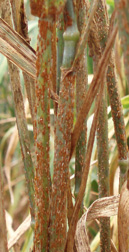Washington, DC, USA
October 24, 2011
 U.S. Department of Agriculture (USDA) scientists have identified a number of stem rust-resistant wheat varieties and are retesting them to verify their resistance.
U.S. Department of Agriculture (USDA) scientists have identified a number of stem rust-resistant wheat varieties and are retesting them to verify their resistance.
Stem rust occurs worldwide wherever wheat is grown. Over a large area, losses from stem rust can be severe, ranging from 50 to 70 percent, and individual fields can be destroyed.
Agricultural Research Service (ARS) plant pathologist Mike Bonman at the agency's Small Grains and Potato Germplasm Research Unit in Aberdeen, Idaho, and his colleagues screened more than 3,000 wheat landraces from the National Small Grains Collection against new races of the stem rust pathogen found in wheat fields in Kenya. Landraces with confirmed resistance are being crossed with susceptible wheat to determine the genetic basis of the resistance.
ARS is USDA's principal intramural scientific research agency, and the research supports the USDA priority of promoting international food security.
Field trials in Kenya to screen for resistance are vital to this work, according to Bonman, who worked at the International Rice Research Institute (IRRI) for 9 years before coming to ARS. He is now working collaboratively with the International Maize and Wheat Improvement Center (CIMMYT) near Mexico City, and the Kenya Agricultural Research Institute (KARI).
Excellent procedures have been developed by CIMMYT and KARI personnel to promote rust disease in the nursery, enabling Bonman to evaluate which ARS accessions are resistant to rust. According to Bonman, CIMMYT facilitates the nursery and site logistics, and ARS helps with evaluating the level of rust development in wheat varieties.
The research team's goal is to find new genes for resistance to a rust strain called Ug99, because that strain has the capacity to overcome many of the resistance genes that have been used for the past 50 years. This work will help Africa's growers now and will help suppress disease and reduce damage in developing countries. It also will prepare the United States for Ug99 if the disease arrives here, according to Bonman.
Read more about this and other cooperative studies between ARS and international research partners in the October 2011 issue of Agricultural Research magazine.
Photo: Ug99-infected wheat at a nursery in Njoro, Kenya. Photo by Yue Jin.
Investigadores identifican variedades criollas de trigo que tienen resistencia a la roya del tallo
Científicos del Servicio de Investigación Agrícola (ARS) han identificado varias variedades de trigo que tienen resistencia a la roya del tallo, y ahora están probándolas otra vez para verificar su resistencia.
La roya del tallo ocurre mundialmente en cualquier sitio donde se produce el trigo. Las pérdidas causadas por la enfermedad pueden ser serias, llegando al 70 por ciento del cultivo, y la roya puede destruir completamente campos individuales.
Patólogo de plantas Mike Bonman y sus colegas en la Unidad de Investigación de Granos Pequeños y Germoplasma de Papa mantenida por el ARS en Aberdeen, Idaho, evaluaron la capacidad más de 3.000 variedades criollas de trigo de la Colección Nacional de Granos Pequenos de EE.UU. de resistir nuevas cepas del patógeno de la roya del tallo encontradas en los campos de trigo en Kenia. Los investigadores están cruzando las variedades que tienen la resistencia confirmada con variedades susceptibles de trigo para determinar la base genética de la resistencia.
ARS es la agencia principal de investigaciones científicas del Departamento de Agricultura de EE.UU. (USDA por sus siglas en inglés), y estas investigaciones apoyan la prioridad del USDA de promover la seguridad alimentaria internacional.
Pruebas de campo en Kenia para evaluar la resistencia son imprescindibles en estos estudios, según Bonman, quien trabajó con el Instituto Internacional de Investigación de Arroz (IRRI por sus siglas en inglés) por nueve años antes de incorporarse a ARS. Él ahora está colaborando con el Centro Internacional de Mejoramiento de Maíz y Trigo (CIMMYT) cerca de Cuidad de México y el Instituto de Investigación Agrícola de Kenia (KARI por sus siglas en inglés).
El personal de CIMMYT y KARI ha desarrollado excelentes procedimientos para promover resistencia a la roya del tallo en plantas de trigo en el invernadero, y estos procedimientos ayudan a Bonman a evaluar cuáles de las accesiones del ARS tienen resistencia a la enfermedad. Según Bonman, CIMMYT facilita la logística del invernadero y de los sitios, y ARS ayuda a evaluar el nivel de desarrollo de resistencia a la enfermedad en las variedades de trigo.
El objetivo del grupo es encontrar nuevos genes que confieren resistencia a una cepa de la roya del tallo llamada Ug99, porque esa cepa tiene la capacidad de vencer muchos de los genes de resistencia que han sido usados por los últimos 50 años. Este proyecto ayudará a los productores africanos y ayudará a suprimir la enfermedad y reducir daños en los países en vías de desarrollo. También ayudará a preparar EE.UU. si la cepa Ug99 sí llega aquí, según Bonman.
Lea más sobre esta investigación en la revista 'Agricultural Research' de octubre del 2011.